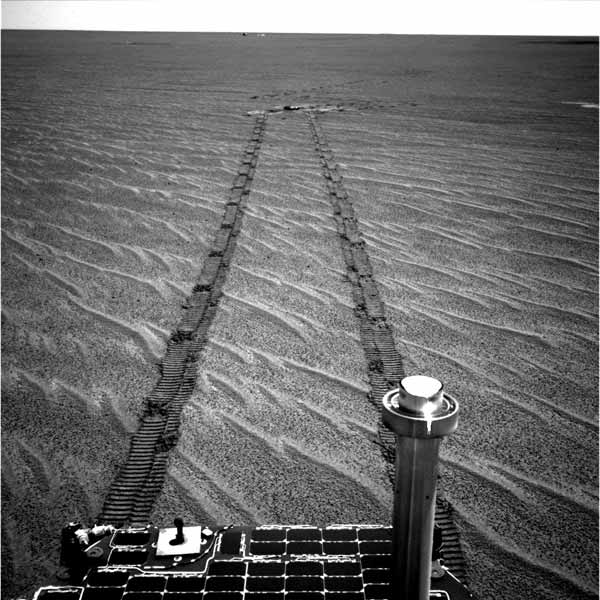Study Suggests Source of Acid Waters That Shaped Mars

The dry rock outcrops on the Martian plains of MeridianiPlanum are thought to have once been bathed in and shaped by acidic waters,based on evidence collected by NASA's intrepid rover Opportunity in its sevenyears on the red planet.
How those ancient waters became so acidic, however, has beenan open question. Now, a new study suggests that these acid waters were createdwhen iron-rich groundwater rose to the surface of Mars and underwent chemicalreactions ? changing the state of the iron and boosting the acidity of thewaters.
As Opportunity has explored the MeridianiPlanum area, it has analyzed sedimentary rocks deposited about 3.7 billionyears ago. The minerals present in the rocks suggest that they formed in aclimate that was arid but that experienced periodic groundwater upwelling.Certain telltale minerals, particularly one called jarosite, suggest that thewaters that washed over the surface and formed the rocks were acidic.
Water on Mars
Some scientists think that the water thatshaped this area of the Martian surface came from below the ground,periodically welling up. But the rock this groundwater would have beensurrounded by basalt, and the chemistry of such a system would have likely madefor neutral-pH water. The pH of a liquid runs on a scale of 1 to 14 (acidic tobasic), with 7 being neutral.
So just how did neutral water become acidic enough (with apH estimated between 2 and 4, or around the acidity of lemon juice or orangejuice) to leave that characteristic mineral signature?
Joel Hurowitz, an Opportunity team member at NASA's JetPropulsion Laboratory in Pasadena, Calif., and his colleagues used chemicalmodels and Opportunity's observations to suggest a mechanism that could answerthat question.
Get the Space.com Newsletter
Breaking space news, the latest updates on rocket launches, skywatching events and more!
If the groundwater was rich in a particular form of iron(picked up from the surrounding basalt), that iron might have undergone achemical transformation when the water reached the surface and was exposed tothe atmosphere, resulting in acidic waters. The iron in the water could havebeen oxidized ? where a molecule or atom loses an electron ? either byultraviolet light or by reaction with dissolved oxygen. This process would haveleft the water with an acidic pH, and the iron would have come out of the watersolution to eventually form the rocks that Opportunity observed.
Acidic Martian water adds up
Hurowitz and his colleagues crunched the numbers to see ifthis mechanism could produce enough acid to explain the conditions atMeridiani. The results seemed to match what Opportunity'sobservations suggested very closely, and "we were sort of pleasantlysurprised by that," Hurowitz told SPACE.com.
Previous suggestions for how the waters became acidicinclude the idea that atmospheric sulfur compounds (possibly generated byvolcanic eruptions) could have fallen as acid rain, much like can happen inpolluted air on Earth. But Hurowitz thinks the iron oxidation explanationbetter fits the observed chemistry of Meridiani and doesn't require the onsetof acid water flow to "perfectly coincide with volcanic exhalations andsulfur coming in from an external source for your acidity."
One key question left, which Hurowitz and his colleagues arealready investigating, is "whether or not you're able to pick up enoughiron along those groundwater flow paths and bring them to the surface and haveall this acid chemistry take place," Hurowitz said.
The findings of Hurowitz's team were detailed in the April 4online early edition of the journal Nature Geoscience.
- Images:Red Planet Revealed
- MarsRovers Most Amazing Discoveries
- Images:Mars Up Close
Join our Space Forums to keep talking space on the latest missions, night sky and more! And if you have a news tip, correction or comment, let us know at: community@space.com.

Andrea Thompson is an associate editor at Scientific American, where she covers sustainability, energy and the environment. Prior to that, she was a senior writer covering climate science at Climate Central and a reporter and editor at Live Science, where she primarily covered Earth science and the environment. She holds a graduate degree in science health and environmental reporting from New York University, as well as a bachelor of science and and masters of science in atmospheric chemistry from the Georgia Institute of Technology.











